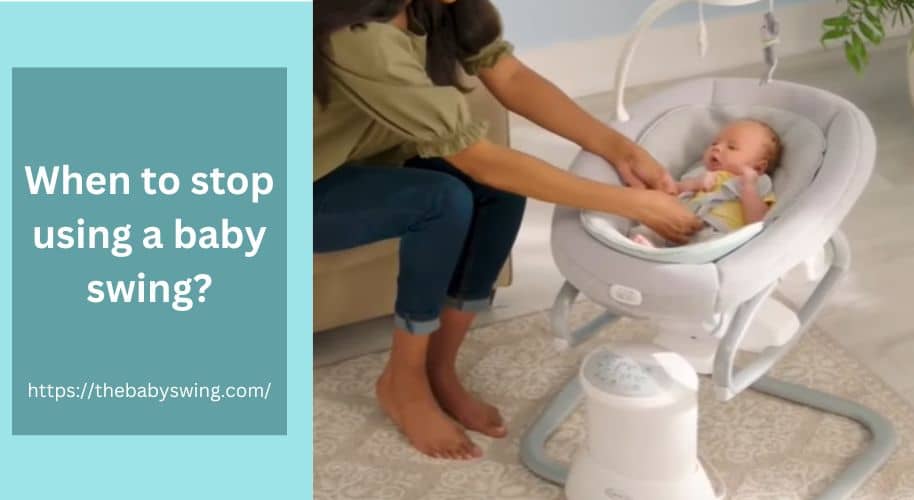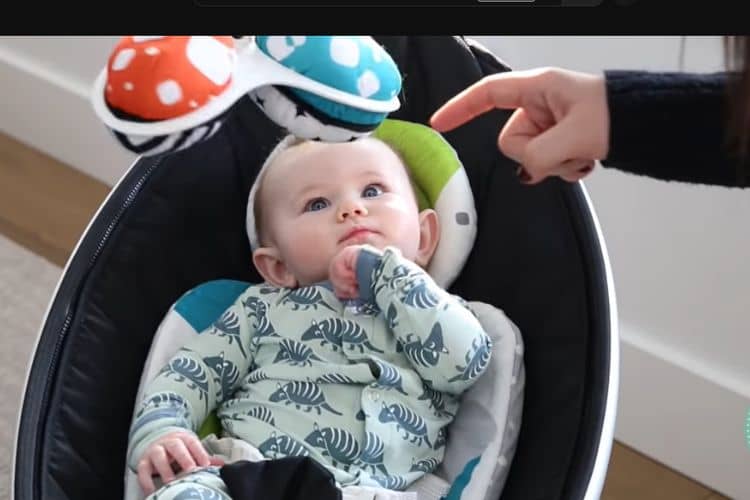Last Updated on July 19, 2023
Generally, babies will outgrow a swing by the time they’re 9-10 months old. However, you should keep an eye on your child’s weight and size as they grow, as once they reach the maximum weight limit stated by the manufacturer, you should stop using the swing immediately.
Additionally, if your baby has started trying to climb out of the swing or has become too mobile for it, you should also discontinue use.
You should also be aware of any safety guidelines that come with your baby swing and follow them closely to ensure your child’s safety.
In this article, we’ll give you more information on when to stop using a baby swing and safety guidelines to keep in mind. So, read on for more details!

- When to start using a baby swing?
- When to stop using a baby swing?
- Watch this video on when do babies outgrow swing
- Safety guidelines for using a baby swing
- How long can a baby sleep in a swing?
- What happens if baby is in swing too long?
- What's the age or weight limit of baby swings?
- When a baby can sit up without support?
- When a baby crawls unassisted or walks without help?
- Wrapping Up
When to start using a baby swing?
The best time to use a baby swing is when your baby is between 3 months old. At this age, they are able to hold their head up and can be safely secured in the swing.
A baby swing can provide a soothing environment for your little one while you take care of other tasks around the house.
It can also help with tummy time as it encourages them to move their legs and arms, which helps strengthen their muscles. Additionally, many swings come with toys that will help stimulate your baby’s senses and keep them entertained.
You should also remember that swings are not a long-term solution for soothing or sleeping. Instead, use them in moderation and be sure to provide plenty of tummy time for your little one so they can develop their motor skills and explore their environment safely.
“Swing use should be limited to about 30 minutes at a time, with plenty of breaks for playtime. Swings are not recommended as an alternative to appropriate furniture designed for sleeping or resting,” says Michael W Perkins, MD, a Pediatrician of The Perkins Pediatric Clinic, LLC.
When shopping for a baby swing, make sure to look for features such as adjustable speed settings, reclining positions, and safety straps. It’s also important to check the weight limit of the swing so that it can accommodate your growing child.
Also read: How long can baby be in graco swing
When to stop using a baby swing?
Most experts recommend making the switch around six months of age, but this can vary depending on your child’s weight and size.
Generally speaking, babies will outgrow a swing by the time they’re 9-10 months old. However, you should pay attention to your baby’s cues and watch for signs that they want to crawl out of the swing, which usually happens around 9 months.
Additionally, you should also keep an eye on the weight limit of the swing – once your baby exceeds it, it’s time to retire it.
“Once your baby starts to become too active or is trying to climb out of the swing, it’s definitely time to transition to other activities,” added Dr. Michael.
Watch this video on when do babies outgrow swing
Safety guidelines for using a baby swing
It’s essential that you follow certain safety guidelines when using a baby swing. These include:
– Always follow the manufacturer’s instructions and guidelines closely.
– Make sure that the swing is on a flat, even surface and away from any hazards.
– Be sure to use safety straps properly to secure your baby in the swing at all times when it’s in use.
– Ensure that toys are secured and cannot fall off or become detached while in motion.
– Do not leave your baby unattended in a swing.
– Remember to limit usage to 30 minutes at a time, as overuse can lead to discomfort for your child.
– Regularly check the swing for signs of wear and tear, frayed straps, or faulty mechanisms that could cause injury. If you notice any issues, stop using the swing immediately.
By following these safety guidelines, you can ensure that your baby is safe and secure in the swing at all times.
Also read: Weight limit on baby swings
How long can a baby sleep in a swing?
No baby should ever sleep in a swing for prolonged periods of time. According to the American Academy of Pediatrics (AAP), swings are not designed for sleeping and can be dangerous if used for that purpose.
Infants haven’t developed their muscles enough to hold up their heads, making them more prone to falls or suffocation. Babies should only be placed in a swing while they are awake and under direct supervision.
If your baby gets used to falling asleep in a swing, you may need to transfer them to their crib once they are sound asleep. This can be difficult as babies may wake up when moved from the swing, so it is important to establish good sleep habits early on.
You can help your baby learn how to fall asleep independently by creating a consistent bedtime routine and setting limits on how long they stay in the swing during the day.
You should also remember that swings are not a replacement for sleep aids like cribs or bassinets. Swings should only be used recreationally while under a caretaker’s supervision and never left unattended with an infant inside.
What happens if baby is in swing too long?

If a baby is left in a swing for too long, it can become dangerous. The American Academy of Pediatrics recommends that babies under 4 months old should not be left in a swing for more than 30 minutes at a time.
Prolonged use of swings can cause the baby to develop flat spots on their head due to the pressure from the seat and can also lead to physical discomfort.
Additionally, if the swing is not properly secured, it could tip over and injure the baby. Parents should always follow manufacturer instructions when using a baby swing and make sure it is securely fastened before placing their baby inside.
Also read: How Long Can A Baby Stay In A Swing? | The Baby Swing
What’s the age or weight limit of baby swings?
The age and weight limit of the swings can vary depending on the brand. Most swings can accommodate babies from 6 to 20 or 30 pounds. Many brands don’t give an age maximum because babies develop so differently.
It is recommended to stop using swings when the baby reaches around 11-12 kg or 25-30 pounds. Some babies are ready for park swings by 6 months of age, but most are not ready until at least 8 or 9 months.
Dr. Michael emphasizes following the manufacturer’s guidelines for your particular baby swing and regularly checking that all straps and fastenings are secure.
Additionally, he recommends limiting the usage of any swing to 30 minutes at a time and never leaving a baby unattended.
He also suggests using swings from reputable brands with up-to-date safety standards to guarantee optimal safety.
“After use, always inspect the swing for any signs of wear or tear and take the necessary steps to fix them before next use,” he added.
By doing so, you can be sure that your baby will have hours of safe playtime in their new baby swing!
When a baby can sit up without support?
When do babies sit up by themselves? Most babies learn to sit up without support between 4 and 8 months of age. However, the process is gradual; some babies may progress faster than others.
To help your baby develop the necessary strength in their neck, upper body and back muscles to sit up independently, you have to provide plenty of tummy time.
Tummy time helps strengthen these muscles and encourages your baby to explore their environment while they are on their stomachs.
You should also remember that every baby develops at their own pace and it is normal for them to reach milestones like sitting up at different times.
If you have any concerns about your baby’s development, speak with your doctor or healthcare provider.
When a baby crawls unassisted or walks without help?
When do babies start walking unassisted? Most babies start walking independently within 2-3 months of learning to stand up by themselves.
However, there are other signs that your baby is ready to walk without help, such as pulling up to stand, becoming a daring adventurer, cruising around, and changing sleep patterns.
Additionally, babies usually learn to crawl between the ages of 7 and 10 months before taking their first steps.
We’ve already mentioned that every child is different and will reach milestones at their own pace. Some babies may walk at 8 months, while others may take 18 months or longer.
To help encourage your baby’s development, you can provide them with plenty of opportunities for practice and support them as they explore new skills.
Wrapping Up
Thanks for reading this guide on when to stop using a baby swing. We hope that you found it helpful and now have a better understanding of when to switch from a swing to other activities for your little one.
Be sure to always follow safety guidelines and any age limits set by the manufacturer.
Please share this article with anyone you know who has a baby and is considering purchasing a swing.
Sources:
- https://www.healthline.com/health/baby/signs-baby-will-walk-soon
- https://parentingscience.com/when-do-babies-start-walking/
- https://www.webmd.com/baby/when-does-a-baby-start-walking
- https://www.healthline.com/health/parenting/when-can-babies-sit-up
- https://www.whattoexpect.com/first-year/sit-up/
- https://www.pampers.co.uk/baby/development/article/when-do-babies-sit-up
- https://www.preciouslittlesleep.com/the-ultimate-baby-swing-sleep-guide-for-swing-hating-babies/
- https://www.cnet.com/health/parenting/how-to-break-your-babys-habit-of-sleeping-in-a-swing/
- https://www.verywellfamily.com/can-babies-sleep-in-a-baby-swing-5100896
- https://www.todaysparent.com/baby/baby-sleeping-in-swing/
Sharing Is Caring!

Dr. Leah Alexander is a board-certified general pediatrician who has been in practice for over 20 years. She began working as a pediatrician at Elizabeth Pediatric Group of New Jersey in 2000. Since 2005, she has been working as an independently contracted pediatrician with Medical Doctors Associates at Pediatricare Associates of New Jersey. Read more
